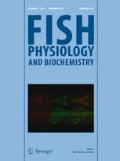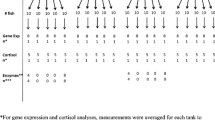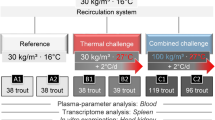Abstract
This study compared the heat-shock response and metabolic energy status in hatchery-raised and two groups of wild-caught steelhead trout parr collected from the Navarro River watershed, California. Wild parr were from coastal and inland sites with different thermal regimes. Fish were exposed in the laboratory to 25 ± 0.2°C for 2-h and the heat-shock response was assessed in muscle tissue via induction of heat-shock proteins (hsps) 63, 72, 78, and 89. Metabolic measurements included muscle phosphocreatine (PCr), ATP, ADP, and AMP, and hepatic glycogen. Inland and coastal fish overlapped considerably with regard to their hsp responses and energetic endpoints, but hatchery fish were distinct in the biochemical patterns they exhibited. Hsp expression levels after temperature shock were significantly lower in hatchery than in wild fish. Hatchery fish also had significantly lower hepatic glycogen and higher muscle ADP, ATP, and PCr concentrations than wild fish. Coastal and inland steelhead did not differ significantly with regard to peak hsp72 and hsp89 levels or to concentrations of energy metabolites. However, fish from the warm-water, inland site expressed significantly less hsp63, maintained higher basal levels of hsp72, and induced hsp89 more slowly than fish from the cold-water, coastal site. Discriminant function analysis revealed that hatchery fish can be distinguished from wild Navarro River fish with 84.9% certainty using the following function: f(x) = − 43.6 + 0.14(Gly) + 4.1(PCr) + 186.4(AMP) + 80.8(ADP) − 0.14(hsp63) + 0.005(hsp72). This study demonstrates that within a single species, rearing conditions or genetic variation can influence an organism’s disposition and cellular response to thermal stress. Extrapolation of results from laboratory studies on hatchery fish to wild fish may therefore not be possible, and caution must be used when interpreting hsp data obtained for wild fish with different thermal histories.




Similar content being viewed by others
References
Ally A, Park G (1992) Rapid determination of creatine, phosphocreatine, purine bases and nucleotides (ATP, ADP, AMP, GTP, GDP) in heart biopsies by gradient ion-pair reversed-phase liquid chromatography. J Chromatogr 575:19–27
Barua D, Heckathorn SA (2004) Acclimation of the temperature set-points of the heat-shock response. J Thermal Biol 29:185–193
Bierkens JGEA (2000) Applications and pitfalls of stress-proteins in biomonitoring. Toxicology 153:61–72
Bosch TCG, Drylow SM, Bode HR, Steele RE (1988) Thermotolerance and synthesis of heat shock proteins: these responses are present in Hydra attenuata but absent in Hydra oligactis. Proc Natl Acad Sci USA 85:7927–7934
Carr RS, Neff JM (1984) Quantitative semi-automated enzymatic assay for tissue glycogen. Comp Biochem Physiol B 77:447–449
Currie S, Moyes CD, Tufts BL (2000) The effects of heat shock and acclimation temperature on Hsp70 and Hsp30 mRNA expression in trout: in vivo and in vitro comparisons. J Fish Biol 56:398–408
Dietz TJ, Somero GN (1992) The threshold induction temperature of the 90-kDa heat shock protein is subject to acclimatization in eurythermal goby fishes (genus Gillichthys). Proc Natl Acad Sci USA 89:3389–3393
Feige U, Morimoto RI, Yahara I, Polla BS (eds) (1996) Stress-inducible cellular responses. Birkhauser, Basel
Hallare AV, Pagulayan R, Lacdan N, Koehler H-R, Triebskorn R (2005) Assessing water quality in a tropical lake using biomarkers in zebrafish embryos: developmental toxicity and stress protein responses. Environ Monitor Assess 104:171–187
Hochachka PW, Somero GN (2002) Biochemical adaptation: mechanism and process in physiological evolution. Oxford University Press, New York
Hofmann GE (2005) Patterns of hsp gene expression in ectothermic marine organisms on small to large biogeographic scales. Integr Comp Biol 45:247–255
Hofmann GE, Somero GN (1995) Evidence for protein damage at environmental temperatures: seasonal changes in levels of ubiquitin conjugates and hsp70 in the intertidal mussel Mytilus trossulus. J Exp Biol 198:1509–1518
Iwama GK, Thomas PT, Forsyth RB, Vijayan MM (1998) Heat shock protein expression in fish. Rev Fish Biol Fish 8:35–56
Koban M, Graham G, Prosser C (1987) Induction of heat-shock protein synthesis in teleost hepatocytes—effects of acclimation temperature. Physiol Zool 60(2):290–296
Krone PH, Lele Z, Sass JB (1997) Heat shock genes and the heat shock response in zebrafish embryos. Biochem Cell Biol 75:487–497
Lund SG, Caissie D, Cunjak RA, Vijayan MM, Tufts BL (2002) The effects of environmental heat stress on heat-shock mRNA and protein expression in Miramichi Atlantic salmon (Salmo salar) parr. Can J Fish Aquat Sci 59:1553–1562
Moyle PB, Cech JJ Jr (2000) Fishes: an introduction to ichthyology, 4th edn. Prentice Hall, Uppersaddle River, NJ
Nakano K, Iwama GK (2002) The 70-kDa heat shock protein response in two intertidal sculpins, Oligocottus maculosus and O. snyderi: relationship of hsp70 and thermal tolerance. Comp Biochem Physiol Part A 133:79–94
Nollen EAA, Morimoto RI (2002) Chaperoning signaling pathways: molecular chaperones as stress-sensing ‘heat shock’ proteins. J Cell Sci 115:2809–2816
Parsell DA, Lindquist S (1993) The function of heat-shock proteins in stress tolerance: degradation and reactivation of damaged proteins. Annu Rev Genet 27:437–496
Podrabsky JE, Somero GN (2004) Changes in gene expression associated with acclimation to constant temperatures and fluctuating daily temperatures in an annual killifish, Austrofundulus limnaeus. J Exp Biol 207:2237–2254
Roberts DA, Hofmann GE, Somero GN (1997) Heat-shock protein expression in Mytilus californianus: acclimatization (seasonal and tidal-height comparisons) and acclimation effects. Biol Bull 192:309–320
Somero GN (2002) Thermal physiology and vertical zonation of intertidal animals: optima, limits and costs of living. Integr Comp Biol 42:780–789
Threader RW, Houston AH (1983) Heat tolerance and resistance in juvenile rainbow trout acclimated to diurnally cycling temperatures. Comp Biochem Physiol 75A:153–155
Viant MR, Werner I, Rosenblum ES, Gantner AS, Tjeerdema RS, Johnson ML (2003) Correlation between stress protein induction and reduced metabolic condition in juvenile steelhead trout (Oncorhynchus mykiss) chronically exposed to elevated temperature. Fish Physiol Biochem 29:159–171
Werner I, Koger CS, Hamm JT, Hinton DE (2001) Ontogeny of the heat shock protein, hsp70 and hsp60, response and developmental effects of heat shock in the teleost, medaka (Oryzias latipes). Environ Sci 8(1):13–29
Werner I, Smith T, Feliciano J, Johnson ML (2005) Heat-shock proteins in juvenile steelhead trout (Oncorhynchus mykiss) reflect thermal conditions in the Navarro River watershed, California, USA. Trans Am Fish Soc 134:399–410
Werner I, Linares-Casenave J, Van Eenennaam JP, Doroshov SI (2006) The effect of temperature stress on heat-shock protein expression and development in larval green sturgeon (Acipenser medirostris). Environ Biol Fish 10.1007/s10641-006-9070-z
Acknowledgements
This research was supported by funding from the California Department of Transportation (Contracts # 43A0014 and 43A0073) to M.L. Johnson. We are grateful to the Warm Springs Fish Hatchery, Geyserville, California, for a generous supply of steelhead parr, and to Gina Lee for conducting the protein analyses.
Author information
Authors and Affiliations
Corresponding author
Rights and permissions
About this article
Cite this article
Werner, I., Viant, M.R., Rosenblum, E.S. et al. Cellular responses to temperature stress in steelhead trout (Onchorynchus mykiss) parr with different rearing histories. Fish Physiol Biochem 32, 261–273 (2006). https://doi.org/10.1007/s10695-006-9105-6
Received:
Accepted:
Published:
Issue Date:
DOI: https://doi.org/10.1007/s10695-006-9105-6




